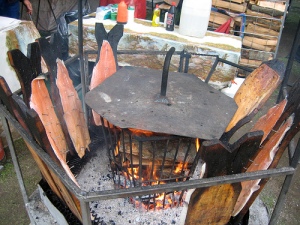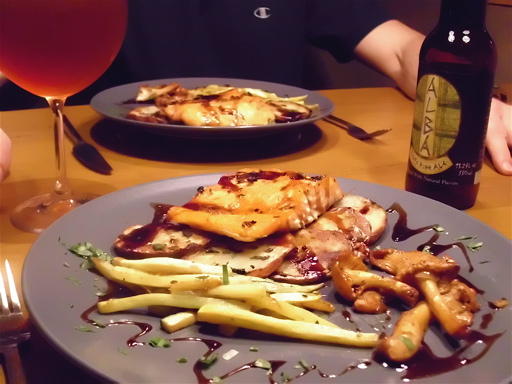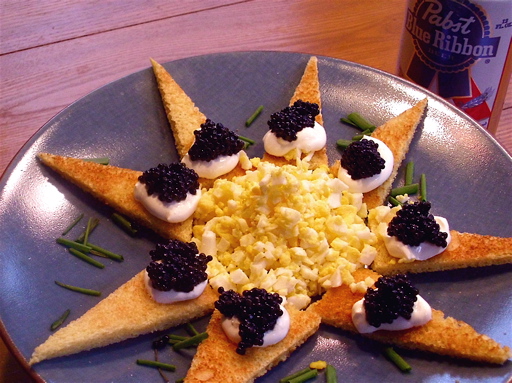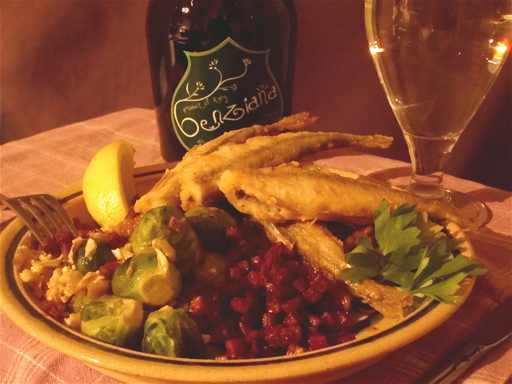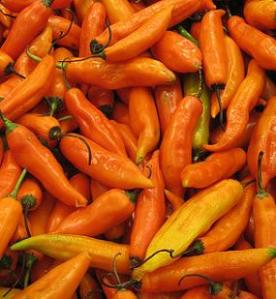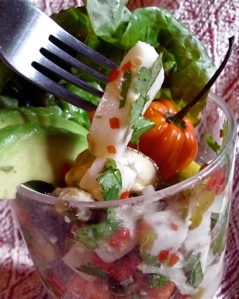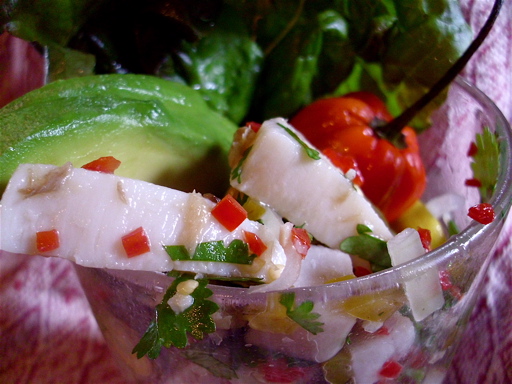Lobster with Vanilla-Blueberry-Mascarpone Ravioli, Asparagus and Three Sauces
Here it is, the massive, freaky effort of molecular gastronomy to be made by the adventurous chef or dreamed about by armchair cooks. Molecular gastronomy? you wonder.
Well, to be clear, the meaning of this term has mutated significantly in the 20 years since its introduction. It can mean anything from the use of industrial gels to create new textures to the abandonment of classical cooking techniques to using biochemistry to explain or predict interesting aroma synergies between disparate foods.
I like Harold McGee‘s definition the best. He calls molecular gastronomy the scientific study of deliciousness. McGee, along with Elizabeth Cawdry Thomas (who ran a SF Bay-area cooking school) and Nicholas Kurti (an Oxford physicist with a passion for cooking), are generally considered the founders of the movement. They presented their first workshop in Erice, Sicily in 1992.
It is well-known that lobster and vanilla are sympathetic flavors. Blueberry and vanilla also work well together. As it so happens, on a desert hike long, long ago, the idea popped into my head that all three could be combined in the same dish. Sort of the mathematical distributive property applied to flavors. But it took me until this year to accomplish the dish.
From the perspective of molecular gastronomy, foods that complement each other often contain similar aroma and flavor compounds. Blueberry’s fruitiness comes from esters like 3-isopropyl-butyrate and its woodsy note from benzaldehyde. Vanillin, the principal flavor compound in vanilla beans, is 4-hydroxy-3-methoxybenzaldehyde. Real vanilla carries with it anther 170 flavor compounds, many of which are also esters. Our body detects similar chemical structures in receptors specific for certain molecular configurations. You can read a primer here.
The real question is why do vanilla and lobster pair well. A study of lobster tail meat by gas chromatography identified 47 aroma/flavor compounds. Among the major constituents were 3-methylbutanal (chocolate, malty) and 2,3-butanedione (buttery). You can see that these are vanilla-compatible flavors.
Due to the complexities of this recipe, I ask your indulgence in not writing out the recipes for all the components and sauces. Instead, I’d rather describe the dish to you, show you a picture, and call it quits for today. Okay?
Lobster with Vanilla-Blueberry-Mascarpone Ravioli, Asparagus and Three Sauces
Since one of the sauces is like a bisque made from the lobster carcass, you have to poach the lobster first, reserving the shelled meat for the finish. There were plenty of good one to two-pound lobbies available. After poaching, I cooled the lobster, removed the claw, thigh (?), and tail meat, and kept it away from Dave’s cats.
The shell and lesser legs were broken up and a salmony-colored sauce was prepared with shallots, butter, saffron, a tomato, a shot of cognac, cream, tarragon, salt and crushed white pepper. The sauce was sieved and kept warm for assembly.
The second sauce was for dressing the asparagus spears. It was a reduction of blueberries and pinot noir with some balsamic vinegar added. The third sauce was based on a beurre blanc and had to be made right at the end.
Next I put together the blueberry vanilla ravioli. Most people will opt for using wonton wrappers, but if you have an Atlas pasta machine as I do, you really should roll your own. The filling was equal parts of mascarpone (sweet Italian-style cream cheese) and ricotta. I found a brand of ricotta – Calabro – with no extra additives and it was worth the few extra cents! Supple and buttery like my homemade ricotta. To this I added an egg yolk, the seeds scraped from a Tahitian vanilla bean, and a pinch each of salt and white pepper. After dispensing the mixture onto the pasta dough I added a fingerful of wild blueberries from Maine. The reserved egg white helped stick the top and bottom layers of pasta together.
Pulling it all together. I boiled water for the ravioli and the asparagus. While those were coming up to heat I began the third sauce, a butter sauce called beurre nantais after the French city of Nantes. White wine (I used the delicious Montevina sauvignon blanc) and white wine vinegar are reduced with shallots until you are left with a sticky, acidic mess. A couple tablespoons of cream are stirred in just before it dries out. Finally butter, lots of it, is whisked in gradually. The result is a luscious off-white, airy sauce. It must be served right away.
Dropping the ravioli and asparagus into their respective water, I plated onto warmed plates by first making a spider web with the lobster sauce and the beurre nantais. The asparagus was laid out like spokes radiating from the center of the plate and the ravioli arranged on top, in the center. The reserved lobster meat, momentarily reheated in a little melted butter, was placed onto the ravioli and the blueberry reduction sauce drizzled around and over the asparagus tips. A few stray blueberries and chopped tarragon completed the presentation.
The Feast of the Seven Fishes 2010 – Final Tally
- No. 7 – Bacalao con Patates Dulces (Spanish-American salt cod and sweet potato casserole), best served with a hoppy American ale
- No. 6 – Moules à la Normande (French-style steamed mussels with creamy bleu cheese finish), serve with a semi-sweet hard cider (check out Farnum Hill).
- No. 5 – Ceviché Mixto (Peruvian cold seafood salad with chilis and citrus juice), served with a cold pilsner or the Classic Cocktail: the Pisco Sour.
- No. 4 – Fried Smelts (Italian, with a mushroom risotto and fennel-burdock side salad), served with an Italian saison-styled beer.
- No. 3 – PBR and Caviar – (Russian-White Trash Fusion) Dine like a rock star, served with ice-cold cheap beer.
- No. 2 – Cedar Plank Salmon – (Nouvelle Native American) First, cut down a cedar tree…
- No. 1 – Lobster with Vanilla-Blueberry-Mascarpone Ravioli, Asparagus and Three Sauces – A massive, freaky effort to be made by the adventurous chef or dreamed about by armchair cooks.
Cheers and Happy Holidays! TPJ
[Ed. TPJ has been under the weather, literally and figuratively – hence the delay. The dish was prepared before Christmas, in case it matters. Many thanks to Neighbor Dave for kitchen privileges and reader BR for suggesting the Seven Fishes thread.]



